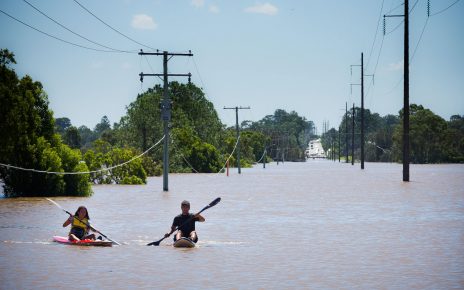Around 15,000 years ago, the Earth’s climate was in turmoil.
Carbon dioxide concentrations were rapidly rising in the atmosphere. Sea levels were rising across the globe. The Northern Hemisphere was heating up. At the same time, the area around Antarctica began to cool down.
And as it cooled, a perplexing trend emerged: Atmospheric CO2 stopped climbing. For a period of nearly 2,000 years, CO2 levels stayed constant at about 240 parts per million.
Scientists learned all this by analyzing samples of ancient ice and sediments, drilled from remote regions of Antarctica. Chemical signatures in these long-untouched samples can provide a variety of information about the Earth’s atmosphere and climate thousands of years in the past.
Until now, the reasons for the mysterious pause in atmospheric CO2 have remained something of a mystery. But now, a group of scientists say they may have solved it.
A new study, published Monday in the journal Nature Geoscience, suggests that changes in Antarctic sea ice are the key.
As the Southern Ocean around Antarctica cooled, winter sea ice cover began to expand. Dust and nutrients would accumulate on the sea ice during the cold months. Then in the spring, much of the ice would melt away and dump these nutrients into the ocean.
Algae and other microorganisms in the water would take advantage of all the extra food, blooming in the sea. These tiny organisms absorb CO2 as they grow—and the more there are, the more carbon they suck out of the atmosphere.
Many of these organisms are eaten by bigger animals. But some of them simply die and sink to the bottom of the sea, where they become locked in sediments on the ocean floor, taking their stored-up carbon with them.
The study suggests that the ocean’s increased biological productivity, driven by the seesawing between expanding winter sea ice and the spring melt, began drawing extra CO2 out of the air during this time period. This helped to temporarily halt the rise of CO2 in the Earth’s atmosphere.
“The ocean is normally nutrient-limited,” said Chris Fogwill, an expert in glaciology and paleoclimatology at Keele University in the United Kingdom and lead author of the new study. “But suddenly you’ve got lots of available nutrients when you’ve got sea ice destruction. And we think that is what was causing the CO2 plateau during that period.”
The scientists conducted their research using a combination of real-life observations and climate model simulations.
First, they analyzed chemical signatures in ancient ice cores, drilled from a valley in the Ellsworth Mountains in West Antarctica. The ice contained a number of biological substances that could only have come from the ocean, likely blown onto the continent in the form of sea spray.
The analyses suggested that the ocean’s biological productivity was increasing at the same time as the atmospheric CO2 pause.
The researchers then ran a series of model simulations, based on what scientists know about the Earth’s climate conditions during this period. The models suggested there were dramatic swings in sea ice extent between the cold and warm months—that is, large ice coverage in the winter and large amounts of melting in the summer.
“So what we seem to see is we have sea ice destruction—so lots and lots of sea ice growth in winter—and then summer it was all destroyed,” Fogwill said.
Southern Ocean carbon sink
The new findings may help crack a long-standing Antarctic debate. But that’s not all. They may also help scientists predict the pace of climate change.
The remote Southern Ocean, as it turns out, is one of the most important carbon sinks on the planet.
Scientists disagree on exactly how much CO2 oceans soak up each year.
Recent research suggests it could be as much as a third of all the CO2 humans emit into the atmosphere. And the Southern Ocean is thought to account for at least half of that amount, all on its own.
That means it plays a huge role in regulating the pace of human-caused climate change.
Scientists are keeping a careful eye on it these days. Some researchers worry that the effects of global warming—including changing wind patterns, shifting ocean currents and declining sea ice—may affect the Southern Ocean’s ability to store carbon in the future. In fact, some studies suggest this process may already be underway (Climatewire, Aug. 24, 2018).
The new research suggests that sea ice may be one of the most important regulators of the Southern Ocean carbon sink.
That’s especially relevant today. Over the last few years, Antarctic sea ice coverage has rapidly declined (Climatewire, July 2, 2019).
What that means for the Southern Ocean carbon sink is still unclear. Some research has suggested that less sea ice, and more open water, can actually contribute to an increase in certain types of microorganisms.
But the new research would seem to suggest that the opposite could also be true. And if dwindling sea ice affects the ocean’s productivity in a way that limits its carbon storage potential, that could speed up the rate of climate change.
“This is something that is deeply worrying from a climate projection point of view,” Fogwill said. “If you haven’t got that deep reservoir of CO2, it could really throw us into a very difficult, very rapid, high-CO2 world, as it were.”
Sea ice isn’t the only factor thought to affect the Southern Ocean carbon sink.
Climate change is also predicted to strengthen certain wind patterns around Antarctica, for instance. Some research has suggested that stronger winds could churn the ocean, bringing carbon-rich currents of deep water up to the surface and allowing them to release more CO2 into the atmosphere (Climatewire, Sept. 5, 2018).
But the new insights into Antarctica sea ice may at least help fill in some of the uncertainties about carbon storage in the Southern Ocean.
“This uncertainty—which is a huge uncertainty in our future modeling—is really important to resolve,” Fogwill said. “By understanding what went on in the past, we can start to test our models to see what potentially will happen.”
Reprinted from Climatewire with permission from E&E News. E&E provides daily coverage of essential energy and environmental news at www.eenews.net.




